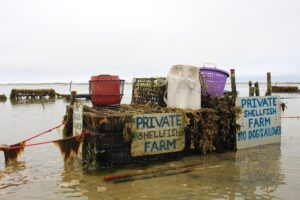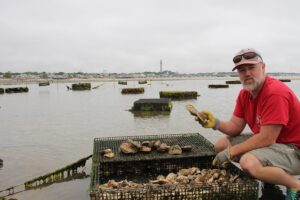PROVINCETOWN — If you set off from the West End boat ramp at low tide and walk out towards the breakwater, it doesn’t take long to reach the low-slung oyster cages that sit on the town’s 38 acres of shellfish grants.

The cages are covered with nine feet of water at high tide but sit on nearly dry ground when the tide recedes. That makes them easier to work than the town’s deepwater grants in the East End, growers report, but it also makes these flats accessible to the many visitors who enjoy the West End beaches — including tourists with four feet.
“I had a bag of oysters, a whole bushel, ready to be sent to my wholesaler when a dog came over and lifted its leg,” said Alex Brown, a longtime oyster farmer. “The owner’s response was, ‘Oh, it’ll just wash out.’ So, I asked, ‘Would you eat it?’ ”
“Dogs have always been a problem,” said Michael Chute, who has farmed oysters on the flats for seven years. “What people don’t understand is that we are farm to table. Our oysters are going less than a mile down the road,” Chute said.
Brown said he quarantines his oysters for 21 days if they have been exposed to dog waste. In Cape Cod’s short summer season, three weeks can be the difference between hitting a peak sales week and missing it. “It’s a long winter,” he added.
Dog owners often fail to retrieve their pets’ poop on the flats, Brown said, even when it is distressingly close to oyster cages.
One dog owner told Brown he didn’t bring a bag with him. “You’ve got two hands — pick it up,” Brown told him.
Provincetown Shellfish Constable Steve Wisbauer said he understands why the town’s oyster farmers are outraged by canine intrusions — but said a greater danger is in the town’s storm drains.

“There’s a conversation here about real and perceived danger,” Wisbauer said. “There are birds defecating out there already. Even with dog poop, the real danger is when it has festered for a long time and the bacteria have taken off.”
Provincetown’s flats don’t provide that opportunity, Wisbauer said. The immense volume of water that washes in and out of the harbor means that, unless dog waste is dropped directly on a cage, the oysters are not likely to suffer from it, he said.
A 10-day quarantine is the formal remedy for an oyster cage that has been in direct contact with dog waste, Wisbauer added. Brown said he does 21 days to err on the side of caution.
Brown also said he has seen many small green bags of dog poop, half decayed, washing up after rainstorms. That is the scenario that Wisbauer worries about.
People discard poop bags into storm drains, where they sit for days in the heat and dark and then get washed out of the town’s discharge pipes in heavy rainfall, Wisbauer said. Those bags are full of bacteria, he said — including the fecal streptococcus that can close beaches and the fecal coliform that can close shellfish grants for harvesting.
“All shellfishing was stopped for several days right after the severe flooding last December,” Wisbauer said. “It was also stopped during the sewer shutdown last August, and when a boat was lodged on the breakwater the year before that.”
Those three very different events all stood to put a large amount of waste — dog or human — into the harbor all at once, Wisbauer said.
The federal Dept. of Agriculture is investing millions in stormwater improvements around Cape Cod, Wisbauer said, including at four large Provincetown outfall pipes: at Ryder Street, Gosnold Street, Pearl Street, and the Coast Guard station.
At present, the large black pipes open right onto the beach. They remain sealed by a large pressure valve in dry weather but open during rainstorms to allow stormwater to escape.
The outfall pipe at the Coast Guard station has a significant impact on water quality in the West End, Wisbauer said.
A project to improve that pipe by adding underground infiltration chambers should be underway either late this fall or next spring, said Jim Vincent, Provincetown’s director of public works.
“We have our share of the money in the stormwater budget already, and the Dept. of Agriculture has committed their 75 percent, so it’s happening,” Vincent said. “We have some final design approvals, but the money has to be used by the end of next year, and we plan to have it done before next summer.”
Even when the outfalls have been improved, however, canines on oyster grants will still be an issue. The Div. of Marine Fisheries has banned dogs from the boats of oyster farmers, Wisbauer said, and new rules for aquaculture forbid dogs on the oyster grants themselves.
Dogs are allowed on town beaches, however, and can be off leash in morning and evening hours in the summer.
Wisbauer and the oyster farmers have been installing signs to alert dog owners that their pets should stay away from the cages. Brown and Chute both said they have run into hostility from dog owners when trying to explain the situation.
“I don’t think people fully understand how it affects us,” Chute said. It’s not just the quarantines, he said — Chute wants to know that his oysters are safe on days he can’t make it to the flats to watch over them.
“I come out here to harvest our oysters in good faith,” Chute said, and he hopes that dog owners will take their obligations seriously, too.



